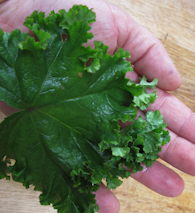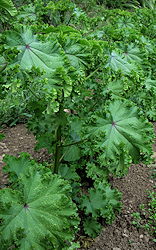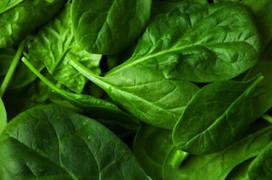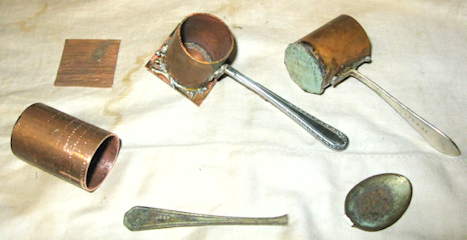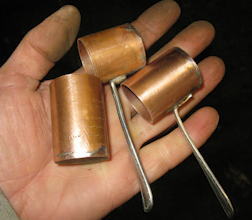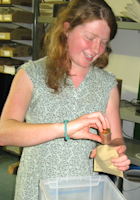Chard, and All Sorts of Other Greens for Cooking:
It's worth scrolling down, as there are all sorts of other interesting greens listed here, as well as the Chard.
Once you've tried all these, don't forget the Kale, Oriental Greens,
and Mustard Greens (which have their own pages) too.
~ CHARD Seed
~
(also LEAF BEET, SPINACH BEET & PERPETUAL SPINACH)
We are very fond of Chard, it provides a great cooked green for nearly
all of the year, easier than spinach.
One of our 'must have' crops, such a good return from even a little
space.
When to sow chard? Two sowings: First sow in spring for crops through summer and autumn.
Or alternatively, sow after midsummer, for the heaviest production over winter and through to the following spring.












































































 = normal sowing & harvest time
= normal sowing & harvest time![]()
 = also possible depending on conditions
= also possible depending on conditions
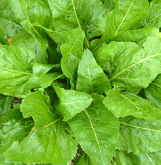
Leaf Beet (aka 'Perpetual Spinach')
This variety of chard is bred to have minimal stem (and maximum leaf) for picking and cooking like spinach. Great for repeated cutting and one of the easiest and most productive vegetables for a a small space. A sowing in late spring can provide greens for almost a whole year, until the plants bolt the following spring.
Light green leaves , minimal stem
 300 seed
£
300 seed
£
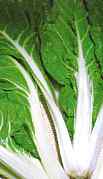 Fordhook Giant
Chard
Fordhook Giant
Chard
Large glossy dark green leaves and wide white stems - a productive plant with tender leaves that reduce less on cooking than other similar greens. Very good value, cropping over a long period.
The unusual thing about this particular strain is that it has very sweet stems. Its nice to eat straight off the plant in the garden, and the stems are also noticably sweet when cooked.
Great in stir-fries & stews too. Dark green, medium white stem.
 250 seed
£
250 seed
£
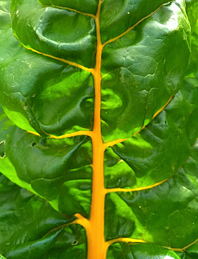 Golden Chard
Golden Chard
A fantastic new chard bred specially for home gardeners. We liked it in our trials because it has really strong colouring on its stems, as well as a good texture and flavour.
The leaves are a nice deep green, and it is very vigorous, making lots of leaves. The deep gold stalks even keep their colour well after cooking.
Very beautiful, as well as tasty. Seed grown for us by Trill Farm Garden.
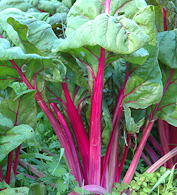 Pink Passion Chard
Pink Passion Chard
An amazing chard with shocking pink stems, and succulent dark green leaves.
It was thought to be extinct, but was rescued from a single packet by the dedicated people at Wild Garden Seeds, and after several years’ work, was available again. Now they are retiring, we have taken over its maintenance, growing what we can each year. We love it because not only is it tasty & productive, it is just beautiful to look at in the garden.
Shocking Pink! Back from the brink of extinction.
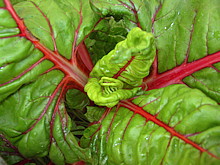 Rhubarb-Red Chard SPECIAL OFFER
Rhubarb-Red Chard SPECIAL OFFER
An extremely striking chard with bright rhubarb-red stems and contrasting green leaves, it does well in the UK climate.
Bred for home gardeners, this is really beautiful in the veg patch and a row of it makes a great decorative broder.
![]() Approx 150 seed
£
Approx 150 seed
£
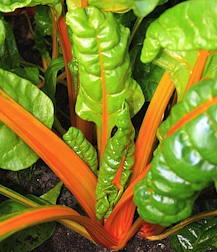
Orange Sunset Chard NEW
We have a lovely orange chard for you to try this year, small-batch organic seeds from the seedhouse of DeBolster, who specialise in breeding varaieties for home-garden growers. Glowung orange-yellow stems and dark-green leaves, this has been selected for cold hardiness, resisting light frosts overwinter.
What a colour!
 Approx 150 seed, organic
£
Approx 150 seed, organic
£
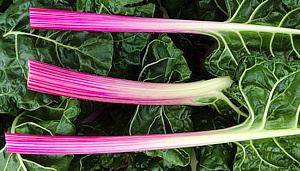
Candy-Striped Chard
Chard that's the colour of a traditional candy-cane! A recent addition , it's a really vigorous chard with dark green leaves and white stems with pink stripes. Absolutely stunning.
This strain is grown for us by Trill Farm Organic Garden, and they have selected for a small amount of yellowy-orange stem colour in some of the plants for a bit of added interest.
You'll mostly get pink and white stripes, but with a few rainbow-orange as well!
 Approx 200 seed, organic
£
Approx 200 seed, organic
£
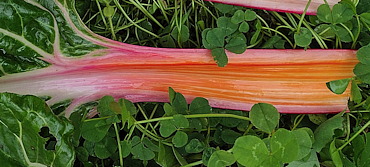
~ TURNIP GREENS ~
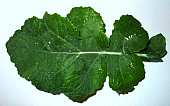 'Turnip Greens (also known as 'Rapa
Senza Testa' )
'Turnip Greens (also known as 'Rapa
Senza Testa' )
Turnip Greens are a really good green from central Europe. A quick alternative to Chard or Kale, ready about 4 weeks from sowing,with mild green leaves that have a wonderfully buttery flavour when cooked, and are also nice and mild if used raw in salads.
Unlike chard it doesn’t take up space for months on end, so you can just throw in a quick row here & there as a catch crop. If grown overwinter the flower shoots in spring are delicious like sprouting broccoli.
Great quick green - give it a go, we think you'll like it! Not ‘turnip-flavoured’ - just a wonderful green on its own.
 1g seed, organic
£
1g seed, organic
£
When to sow? It bolts in the heat, so either sow very early for spring greens, or sow after midsummer for a maincrop harvest in late summer / early autumn.
Small screen: Turn your device sideways to view sowing calendar.




















































 = normal sowing & harvest time
= normal sowing & harvest time![]()
 = also possible depending on conditions
= also possible depending on conditions
~ HUAUZONTLE ~
Delicious edible leaves, but the best bits are the flowering shoots. They can get about 3 to 5 ft tall, and almost as wide. The leaves go red as nights cool, looking very pretty.
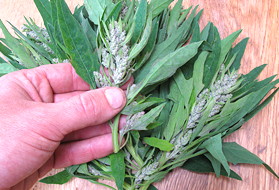 Easily picked, just take the top 3 inches of each flower stem (which will have both leaves and flowers) and cook like spinach or chard.
Easily picked, just take the top 3 inches of each flower stem (which will have both leaves and flowers) and cook like spinach or chard.
They keep a great texture when cooked, with a very slight crunch to them. Not chewy - but they just don't go completely soft the way that for example spinach does. So a great thing to mix in with rice, potato cakes, couscous or stir-fries, as an easy way to make a very simple and plain dish seem really special.
Search on the internet for 'Huauzontles' for lots of Mexican recipes for fritters and more! But they're great cooked simply and quickly like spinach. We plant around half a dozen plants in our home garden each summer, to supply us with shoots from mid-summer right through to the middle of October.
Small screen: Turn your device sideways to view sowing calendar.






















































 = normal sowing & harvest time
= normal sowing & harvest time![]()
 = also possible depending on conditions
= also possible depending on conditions
Botanically speaking, this is Chenopodium berlandieri. The baby plants look similar to the weed Fat Hen - so don't weed them out by mistake!
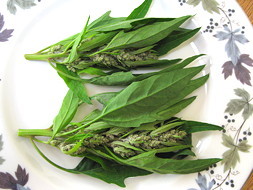
 approx 200 seed, organic
£
approx 200 seed, organic
£
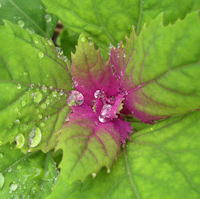 'Magentaspreen' Giant Goosefoot
'Magentaspreen' Giant Goosefoot
This is a very attractive and easily grown plant, used both for salads and cooked greens.
Thes bright green leaves are frosted with a sparkly magenta colour when young. It is very pretty in salads, but makes a delicious cooked green too.
Easy to grow, but it needs cool nights to germinate. Therefore early spring sowings (up to end March) are fine under cover, but make later sowings outdoors so they don't get too hot.
Delicious cooked like spinach. The baby plants look very much like the common weed 'Fat Hen' so don't pull them up by mistake.
 hundreds of seed £
hundreds of seed £

~ VEGETABLE MALLOW~
With this variety we think we've found a winner. It grows really well , looks handsome, and - the key thing - tastes really good and is an excellent addition in the kitchen.
The seed is sown from mid to late spring. We start it in modules since (as with most greens) slugs can be a problem for baby plants, but as soon as it is beyond seedling stage it really gets going and is an easy source of greens - absolutely loads of big, curly edged leaves - they can be used for salad when young, but we think they're best cooked.
You'll need to allow the plants plenty of space and pick them regularly, as they get pretty big, to 4 feet. Just to avoid any disappointment or confusion, the plant doesn't make much in the way of flowers - they're very small and insignificant - but it's still a good looking plant.
Unusual, tasty leaf green, exceptionally productive. Good texture and flavour..
 approx 100 seed, organic
£
approx 100 seed, organic
£
Small screen: Turn your device sideways to view sowing calendar.






















































 = normal sowing & harvest time
= normal sowing & harvest time![]()
 = also possible depending on conditions
= also possible depending on conditions
~ SPINACH Seed ~
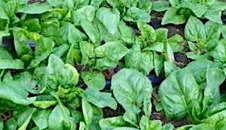 "Winter Giant" Spinach
"Winter Giant" Spinach
We are really pleased to have found a source of Winter Spinach with good germination, and what is a well-maintained line of stock seed.
This modern variety is related to the old heirloom "Monstreux de Viroflay" - famous for its huge tender leaves for use over winter - that has been carefully improved by traditional breeding methods. It has been reselected and is less likely to bolt if the weather gets hot.
Just to be clear , this is Winter Spinach, a cool-weather plant.. You sow it at the end of summer, for use over winter. Don't try to sow winter spinach in Spring, as it would bolt (go to flower) as soon as the weather warms up. But sowing this at the end of summer should give you large amounts of tender spinach over winter.
Small screen: Turn your device sideways to view sowing calendar.






















































 = normal sowing & harvest time
= normal sowing & harvest time![]()
 = also possible depending on conditions
= also possible depending on conditions
Large tender leaves from an old heirloom, with added resistance to mildew.
 a generous 500 seed to allow sucessive sowings, organic
£
a generous 500 seed to allow sucessive sowings, organic
£
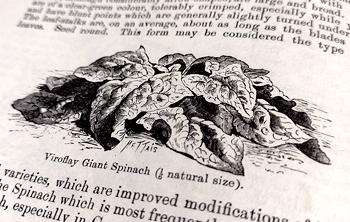
"Monstreux de Viroflay" WINTER Spinach
This is the original, such an old variety, unchanged from the 1800's - here's the engraving in our copy of 'The Vegetable Garden' of 1885. It's a large-leaf spinach for sowing in late summer and harvest November to Spring.,and will benefit from rich soil as it grows really big so needs plenty of fertility.
This is Winter Spinach, a cool-weather plant.. You sow it at the end of summer, for use over winter. Don't try to sow winter spinach in Spring, as it would bolt (go to flower) as soon as the weather warms up. But sowing this at the end of summer should give you large amounts of tender spinach over winter.
Small screen: Turn your device sideways to view sowing calendar.






















































 = normal sowing & harvest time
= normal sowing & harvest time![]()
 = also possible depending on conditions
= also possible depending on conditions
 at least 500 seed to allow sucessive sowings,
£
at least 500 seed to allow sucessive sowings,
£
Summer spinach is sown from spring-time onwards, it's a great summer vegetable for cooking and salads, but it does need regular watering or it will run to flower.
Small screen: Turn your device sideways to view sowing calendar.






















































 = normal sowing & harvest time
= normal sowing & harvest time![]()
 = also possible depending on conditions
= also possible depending on conditions
Really nice in salads or cooked.
 a generous 500 seed to allow successive sowings
£
a generous 500 seed to allow successive sowings
£
~ LEAF AMARANTHS ~
We tried lots of different ones before we found these that do well in the UK climate, so if you've grown them before and been disappointed, or been told that 'you can't grow amaranth in the UK' - definitely give these a try. We've had great reports back from all over the country - including as far north as Ullapool.
Sow amaranth in mid to late spring, starting it off in a seed tray. Don't plant out too early, it will do much better set out in June and will quickly catch up and overtake crops sown earlier in the year!
Small screen: Turn your device sideways to view sowing calendar.




















































 = normal sowing & harvest time
= normal sowing & harvest time![]()
 = also possible depending on conditions
= also possible depending on conditions
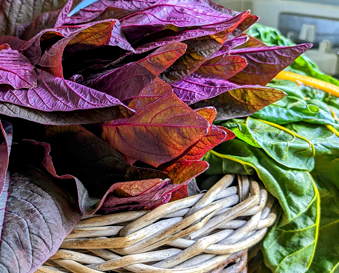
'Kerala Red' Leaf Amaranth
Originally from India, with intensely red leaves, stems and flowers. It produces large quantities of delicious dark red leaves for use as a vegetable either on their own or in soups, stews and of course, curries.
Similar to the varieties often called 'Calalloo', it is so beautiful you may be tempted to grow it in the flower garden instead of the vegetable plot. If you let it go to seed it makes an amazing display with its red flowerheads, though it is better picked for eating at a younger stage.
Intensely red, use for cooking or pick baby leaves for salads
 at least 200 seed, organic
£
at least 200 seed, organic
£
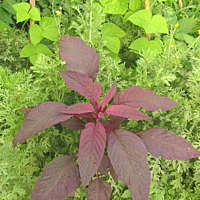
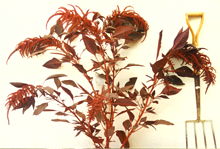
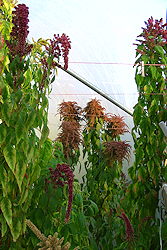
Mixed Leaf Amaranths
Amaranth leaves make a really good cooked green. The leaves and young shoots are tender and delicious. , and they grow well off the ground, so need much less washing than say spinach.
This is a mix of tall, high-yielding types such as 'Annapurna', 'Oscar Blanco' and other interesting crosses we have bred and selected in our trials. Crops heavily over a long season - they just keep making more & more shoots as you pick them. When it finally does go to flower, the seeds are white, so you can collect them for grain too.
These are amazing. In a polytunnel (pictured right) our best plant grew 15 feet tall, making 10kg of plant from a 0.0002g seed - that's a 50-millionfold increase in biomass in just 90 days! (Outdoors you'll get a much more manageable 2 or 3 ft tall plant.)
Moderately easy to grow: Growing requirements are similar to tomatoes when small, but a bit less fussy once the plants get going.
A mixture for leaf production. Bred by us from varieties suggested by Amaranth specialist David Brenner of Iowa State University.
 about 200 seed, organic
£
about 200 seed, organic
£
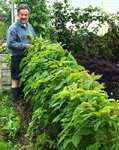
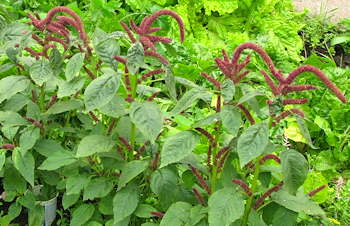
'Calalloo' Leaf Amaranth
This amaranth was sent in by an allotment grower, and when we tried it out it did very well for us.
It is the proper 'calalloo' species, and we were really happy to get it, because in general real Calalloo doesn't do well in the UK, but this variety has obviously been reselected for our conditions. It grew really well, even in the awful summer of 2012.
Green leaves, for cooking, with pretty red flowers.
 at least 200 seed
£
at least 200 seed
£
~ SORREL ~
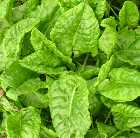
'Belleville' Leaf Sorrel
We are always surprised how few people grow sorrel, and we would encourage you to try this rather fine vegetable. Very easy to grow, producing clumps of pale green leaves with a good sharp lemon flavour - great in salads, as a lettuce substitute in sandwiches (doesn't go limp) and also very good cooked in soups and sauces.
One of the earliest green crops to start in spring and perennial - once you've got a clump going it needs no attention other than when you want to eat it. Hardy, early salad. Lemony!
Hardy, early salad or cooking leaf green, very easy to grow. Comes back each year.
 about 800 seed
£
about 800 seed
£
Small screen: Turn your device sideways to view sowing calendar.





















































~ ORACH ~

Red Orach
Orach grows quickly early in the year, supplying large tender heart-shaped leaves for salad, or it is delicious cooked. This variety has deep red leaves that look great in the garden and on the table.
You sow the seed from May onwards, for harvest over the summer.The plants grow to 1m tall (looking very pretty) , but are better picked when smaller as they are nice and tender when young.
This unusual plant makes both small black and larger tan seeds; sometimes we may pack one or the other, or both as a mix - but all give the same resulting plants so do not be alarmed when you open your packet!
 about 100 seed, organic £
about 100 seed, organic £
Small screen: Turn your device sideways to view sowing calendar.




















































 = normal sowing & harvest time
= normal sowing & harvest time![]()
 = also possible depending on conditions
= also possible depending on conditions






